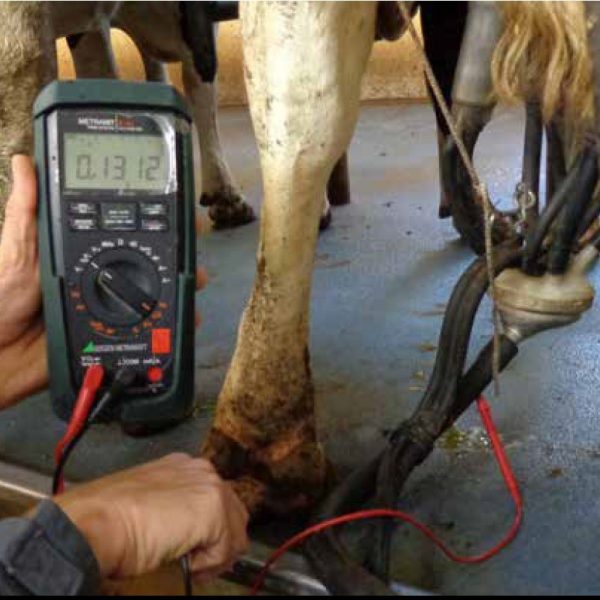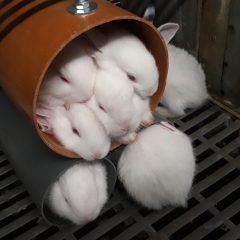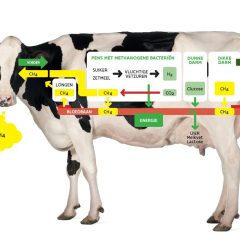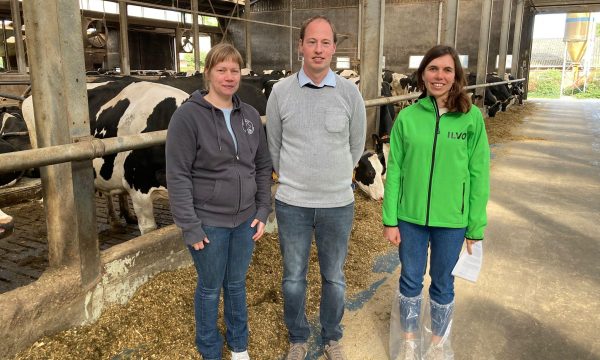Dossier Stray voltage in the dairy barn
For cow welfare and to prevent abnormal cow behavior, it is important that the dairy barn is free of stray voltage. What is stray voltage, how do they occur and what to do about it are all addressed in this dossier. Including 7 tips to prevent stray voltage!

What does ILVO do?
-
 The stray voltage measurement protocol was validated in practice by ILVO and partners and further explained during 5 practical trainings.
The stray voltage measurement protocol was validated in practice by ILVO and partners and further explained during 5 practical trainings. -
 The checklist consists of 14 simple questions that the dairy farmer can answer based on experiences in their dairy barn
The checklist consists of 14 simple questions that the dairy farmer can answer based on experiences in their dairy barn -
 Knowledge is disseminated to dairy farmers, (milking machine) technicians and consultants
Knowledge is disseminated to dairy farmers, (milking machine) technicians and consultants
What is stray voltage?
Stray voltage is electric current that leaves the usual power circuit and starts roaming around. All conducive parts in the barn can carry a slight electrical currrent as a result. From stalls to water troughs and from rafters to milking nipples. If a cow comes into contact with this conductor, and its body is the path of least resistance to the ground, the current will flow to the ground via the cow's body.
Abnormal behaviors
When stray voltage is present, animals will do everything they can to avoid contact with the source. When stray voltage is present in the barn you will therefore see abnormal cow behavior. For example, cows that refuse to enter the milking parlor or milking robot, are very restless or do not drop their milk, they avoid certain cubicles or don't approach the feeding fence ... With stray voltage at the water trough, you will see that cows first touch the water with their tongue and then lick or roll before they dare to drink. All of these symptoms can then in turn lead to secondary problems such as failure to milk, mastitis, not enough lying down, reduced water or feed intake. In some cases, these problems can further lead to rumen acidification, claw or fertility problems. This wide array of symptoms, which can of course also have other causes, does not always make it easy for the farmer to establish the possible link with stray voltage.
Sharing insights about stray voltage
Belgian dairy farmers regularly inquire about stray voltage. Exact figures are not available but it is more than likely that latent problems are present in practice. That is why ILVO, together with dairy machine manufacturers and livestock farmers, is leading an operational working group that is researching stray voltage. This EIP project is funded by the Flemish government and the European Agricultural Fund for Rural Development (EAFRD).
Baart Eloot (ILVO): "The working group collects and bundles existing knowledge on measurement methods, detection and so on. We then share this with dairy farmers, (milking machine) technicians and consultants.
How to prevent stray voltage?
The same grounding for all electrical appliances and conductive parts in the barn is the main way to prevent stray current. In this way everything has the same equipotential, i.e. the same grounding resistance. ILVO recommends a maximum grounding resistance of 6 to 7 Ohms.
Stray voltage loves moisture
Compared to humans, cows are more sensitive to stress differences. On a dairy farm you will find in wet - thus sensitive - conditions, such as water troughs or the milking parlor and milking robot. Electric current conducts well in these places. The places where the cow comes into contact with metal parts such as fencing (fence,...) under moist conditions pose the greatest risk. Especially the cow's mouth and teats are very sensitive to electric current.
The milk measurement can also cause a nuisance for the cow. It is not directly connected to the grounding, but it does work with electricity. In case of a defect, even the milk can become conductive. This is disastrous for the sensitive teats and the cow's well-being. Other causes of stray voltage are mainly insulation or cables that have been gnawed by rodents, too much voltage on a cable, a rusty ground cable or incorrect connections with new equipment.How can stray voltage be detected?
Detecting stray voltage is complex. First of all, because the place where you see the abnormal cow behavior is not necessarily the source. For example, a chewed cable hitting a metal support beam can result in the cows avoiding certain cubicles. Also, stray voltage may only occur under certain circumstances. For example, only after cleaning the milking robot or in humid weather conditions because the insulation around a cable is only slightly damaged.
Measuring stray voltage
The operational working group is working on a fixed measurement protocol. We measure the grounding resistance with a voltmeter and a 1,000 Ohm resistor in parallel to mimick the cow, as it were. Both the primary and the secondary side of the installation are measured. On the primary side, the minus pole of the voltmeter is connected to the ground in the electrical cabinet. Then the plus pole is brought into contact with the metal structures in the barn. A maximum voltage difference of 1V is used as a standard here. On the secondary side (e.g. after a transformer), one pole is connected to one of the power cables, the other pole to the place where one wants to know the potential difference (e.g. the milk line). A maximum voltage difference of 0.5V is allowed here.
The standard we use for a voltage difference is a maximum of 0.25 Volt, above which you will see abnormal cow behavior. If the abnormal cow behavior persists after ruling out more obvious causes, it is best to call in an expert. In this way you can exclude stray voltage or find it and deal with it.
7 Tips to prevent stray voltage
- For new construction, also make a plan for your grounding rail and associated potential equalization rails, to which you will connect all conductive parts. This already starts with the grounding of the reinforcements in the concrete.
- When adding new construction, make sure that new appliances such as fans or a click-on robot are also connected to your existing grounding.
- Work with qualified mechanics and electricians who understand proper grounding. Also, make sure you have good communication with them!
- Make sure everything in your barn has the same equipotential. Don't forget your selection gates and fattening robots.
- Control mice and rats. By gnawing through the insulation around power cables, metal can come into contact with conductors.
- Realize that if you have a high-volume connection, you will have to deal with external grounding, which can bring in other alternating currents on your farm. The same is true if your barn is close to a transformer station.
- If you see abnormal cow behavior, be sure to call in an expert to detect or rule out stray current.










